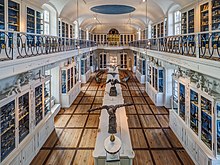Natural History Museum (Bamberg)
 Museum entrance |
|
| Data | |
|---|---|
| place | Bamberg |
| Art | |
| opening | 1791 |
| operator |
Lyceum Foundation Bamberg (sponsor);
General Directorate of the State Natural Science Collections of Bavaria (scientific supervision) |
| Website | |
| ISIL | DE-MUS-012117 |
The Natural History Museum in Bamberg shows exhibits on natural history in historical rooms . There are also rooms for changing exhibitions.
history
Prince-Bishop Franz Ludwig von Erthal von Bamberg established the Natural History Museum as a natural history cabinet in 1791 . The aim was to record, collect, catalog and research the biology and geology of the Bamberg Monastery .
In order to combine research and teaching into a single unit in the interests of Enlightenment , the natural history cabinet was housed in the rooms of the university in the Jesuit college in the island city, where it is still located today. The target group were professors and students of the university, less interested lay people.
After the university was closed, the Natural History Cabinet was re-established in 1803 and, under the direction of Dionysius Linder (1762–1838), took on pomological collections from the Benedictine monastery of Banz in 1822 . The current Lindersche Naturalienkabinettsstiftung was successively expanded; Julius von Minutoli donated numerous exhibits from his trips to non-European countries.
Today the Bamberg Natural History Museum is owned by the Bamberg Lyceum Foundation. The General Directorate of the Bavarian State Natural Science Collections in Munich oversees the museum.
Employees of the Natural History Museum in Bamberg were in charge of the development of the fossil-rich Wattendorf limestone .
Bird hall
With the bird hall, the natural history museum has the only original museum showroom from the 19th century. The hall, completed in 1810, was used by professors and students as a classroom; Its conception is more in line with the requirements of the academic world than it is today with regard to museum education. Thus, the bird hall is a museum within the museum, in which the bird collection was concentrated, from which the name of the hall originated. European and exotic birds are presented on the lower floor, while invertebrates, fish, amphibians, reptiles, exotic songbirds, mammals and botany can be seen in the gallery.
Why the bird hall was never modernized is unclear. After the natural history cabinet lost an important function, namely teaching, due to the dissolution of the university in 1803, the Bavarian crown, as the new owner, was probably not interested in modernizing it, and Linder was primarily interested in preserving the fruit science collection he had built up since 1790 .
In the 1970s, the hall was renovated, with the showcases being painted in creamy white . In the renewed renovation that began in 2006 and ended in 2010, the original color was restored in muted white on the outside and mountain blue on the inside .
Collections
The Natural History Museum has around 200,000 collection objects from the fields of geology , mineralogy , paleontology , zoology and botany .
Particularly noteworthy are:
- Mineral collection from long-extinct sites in the eastern Bavarian basement.
- Collection with over 2000 documents on around 60 historical ore deposits in Upper Franconia , the northern Upper Palatinate , the Spessart and the Odenwald .
- Collection of around 1000 White Jurassic ammonites , including type material.
- One of only about 24 complete dermoplastics of the African quagga surviving worldwide .
- Regional insect collection with a focus on Hymenoptera . With around 60,000 individual specimens, it documents the species population in the Bamberg area around 1930.
- Historical collection of exotic birds.
- Rare collection of around 200 wax models of local fruits, mainly apples , pears and cherries from the turn of the 18th and 19th centuries. Most of the varieties are no longer grown.
Web links
- Literature from and about Natural History Museum in the catalog of the German National Library
- Site of the Natural History Museum Bamberg
- Natural History Museum in Bamberg at bamberg.bayern-online.de
- Bamberg Natural History Museum at gobamberg.de
Bird hall
- The bird hall in the Natural History Museum Bamberg at www.vogelsaal.de
- Bamberg Bird Hall in the Natural History Museum at www.bamberg.info
Individual evidence
- ↑ In 2019 Franconia on the Jura beach and special exhibition on the subject of "Wolf".
- ↑ www.naturkundemuseum-bamberg.de: Franconia on the edge of the Jura - petrified treasures from the Wattendorfer lagoon .
- ↑ The Bird Hall in the Natural History Museum Bamberg , leaflet, Bamberg , undated (received in 2019).
Coordinates: 49 ° 53 ′ 40 ″ N , 10 ° 53 ′ 18 ″ E
